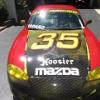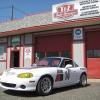- One of the members of our race team acquired a 2001 VVT Spec Miata. He has no engine history on the car. The car seems down on power. I suggested that he do a compression and leakdown test. In general his compression averaged 175 lb,. with a 4% deviation. The leakdown test only showed a small average leakdown of 2%. I believe the compressions of a VVT should be 200+, but shouldn't the leakdowns be a lot more due to the compression being so low. Has anyone seen this?

#1

 Posted 09-18-2021 04:21 PM
Posted 09-18-2021 04:21 PM

#2

 Posted 09-23-2021 11:17 AM
Posted 09-23-2021 11:17 AM

How accurate is your gauge? Put it on the dyno and see how down on power you are..
#3

 Posted 09-23-2021 11:32 AM
Posted 09-23-2021 11:32 AM



#4

 Posted 09-23-2021 12:12 PM
Posted 09-23-2021 12:12 PM

The best way to evaluate any car is starting with a know bench mark. Its all relative after that. Compression gauges are notorious for miss information, but i have never had numbers above 190 on anything miata and who knows what the real number was.
- Steve Scheifler likes this
Frank
TnT Racing
SCCA Ohio Valley Region




#5

 Posted 09-26-2021 06:28 AM
Posted 09-26-2021 06:28 AM

The gauges are accurate as I use them on my car and they produce accurate results. I thought about it for a while and got to wondering if VVT head was mated with a NA8 block by the prior owner. The difference in Compression ratio of the NA8 pistons mated with the 2001 VVT Head I believe would explain the issue. The car is not in my garage I'll report back what I find.
#6

 Posted 09-26-2021 12:38 PM
Posted 09-26-2021 12:38 PM

We have a VVT in our stable that just whistled 9.7 in Daytona and was in the 170's for compression. Made decent power,nothing stellar but ran well enough. Engine was originally built for 12hr endurance races, so builder went for reliability and left some on the table. Many variables with compression numbers alone, cranking RPM, throttle open/closed, gauges vary make to make,etc...
#7

 Posted 12-12-2021 11:09 AM
Posted 12-12-2021 11:09 AM

For compression and leak down numbers to mean anything they must be performed on a warm engine. The rings and valves are sticky when they are cold and the piston to wall clearance is greater when cold allowing the piston to rock more affecting the ring seal. There are many more things but…. Cold numbers are meaningless; don’t do it and expect anything you can count on.
First, compression numbers are testing the engines ability to pump, period. The numbers are static at cranking speed but you can check compression while the engine is running. It gives better results, you will get very low numbers at idle but you will see it jump when the throttle opens. Like when a NB intake valve recedes, the idle number will be low, like 50 or 70 but it comes up at high RPM. So the engine will misfire at idle buy fire, at reduced power, with some throttle. The idle numbers are low because you are compressing a vacuum, this is why the plugs need to be removed and/or the throttle should be open.
Leak down tested the pumps ability to hold pressure, period. Take a 2% motor with good compression numbers and move the cam by one tooth. The leak down will still be 2% but the compression numbers will be lower. Cheaters please note that the Mazda Speed intake cam and altering the cam timing will have this same affect so your numbers will be lower than your legit counterparts that you are comparing to. Heads at minimum spec will pump lower than taller heads of the same combustion volume due to the cam timing being later. There are more things but I am sure you get it.
#8

 Posted 12-12-2021 01:10 PM
Posted 12-12-2021 01:10 PM

As for doing compression tests on a running engine, perhaps there’s some scenario where that makes sense but it’s not something I’ve ever needed to do.


#9

 Posted 12-23-2021 06:33 PM
Posted 12-23-2021 06:33 PM

Steve, feel free to disagree but it would not be wise to pull down an engine based on cold leak down numbers just as it would for cold dyno numbers. before we go into the weeds, we are suppose to be helping someone with a question/concern and he has 2% numbers and 170 ish compression so if his numbers are good, they are good. BTW, there is no spec for the orifice between the two pressure gauges. Usually both gauges are at 100 PSI with no leak (but can be any pressure) and the difference comes from the choked flow of the orifice. The flow is tied to the leak down numbers and is somewhat ambiguous and arbitrary. The using 100 PSI and 100 PSI for the no leak condition will give you the percent in pressure drop of the choke from the orifice. If your leak down gauge has a big orifice, it will give you good numbers and a small one will give the same engine bad ones. BTW orifice sizes are usually 0.040" (actually 1.0 mm or 0.03937") and that is too big for a 3" bore. it is better suited to a 5" bore but there is no standard. Also, the hose length matter to some degree too. I could write a lot more about his but you get the drift. It would be better to make your own or al lease reduce the orifice size. That would be unless you want all the numbers to be good.
#10

 Posted 12-23-2021 07:54 PM
Posted 12-23-2021 07:54 PM



#11

 Posted 12-28-2021 03:48 PM
Posted 12-28-2021 03:48 PM

Steve, I didn't say they were worthless, that was someone else. I did say, however; I wouldn't judge a cylinder bad by a cold number. You pretty much agreed with me so there is no issue. I have a lot of experience with cylinder bore finish, rings and many other very specific engine information. I don't want to get into a spat with someone that has 2,700 posts as I don't have the time and energy for that. I hesitate to post for this very reason, however, I was trying to share some knowledge her and help someone. I am not looking for any business as I am done working and don't need the money. I would suggest that you run your leak down gauge at 100 PSI and use an orifice of 0.040" or less. Some aircraft gauges are 0.060 for over 5" bore and will call 3" bore good when it isn't. the 0.040" orifice is better suited to a Chevy V8 with 4" plus bores.
I worked on a project that the cylinder was barrel shaped, nominal at the top and bottom but big in the middle, due to the casting splitting around the liner. Leak down is usually performed at TDC. With the cams removed and a fixture to lock the ring gear, you can check at intervals. as for getting low numbers with the right orifice, the block surface finish (Rpk, Rk,Rvk, see attachment) The hone angle matters too.
This is from a very strong engine that I built for a friend, you will notice I cut the specs off. This was hot honed with a plate, diamond hones on a CK 30, it has bore correcting capabilities. Note the the waveyness profile is in uin so it is very straight. When I mentioned checking the engine hot, I know haw much the cylinder expands at temp. The has a 3X affect on ring end gap. This engine got very good lead down numbers with a very small orifice, hot that is. Too bad, I wasn't allowed to post the image, PM me and I will send it.
0 user(s) are reading this topic
0 members, 0 guests, 0 anonymous users




 Sign In
Sign In Create Account
Create Account



 Back to top
Back to top Report
Report





